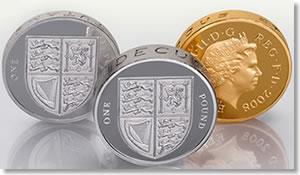 The British Royal Mint has announced the sale of individual proof £1 gold, silver and Piedfort silver coins featuring Welsh graphic designer Matthew Dent’s rendition of the heraldic shield of the Royal Arms — only the third coin reverse version since 1983.
The British Royal Mint has announced the sale of individual proof £1 gold, silver and Piedfort silver coins featuring Welsh graphic designer Matthew Dent’s rendition of the heraldic shield of the Royal Arms — only the third coin reverse version since 1983.
The coins have an extremely low mintage with the 22 carat gold piece limited to just 1,000 and each .925 sterling silver coin set to only 5,000.
Collectors may purchase the gold, silver and Piedfort silver proof coins for £425, £49.95 and £29.95, respectively. (See International Currency Converter.)
The Piedfort £1 is unique in that it’s twice the weight and double the thickness of its circulating counterpart. While it has the same 22.5 mm diameter as the non Piedfort silver proof, its weight is doubled at 19 grams.
The £1 gold proof piece weighs 19.62 gms and has the same 22.5 mm diameter.
The obverse or heads side of the coins has an image of Her Majesty The Queen by Ian Rank-Broadley FRBS.
History of Royal Arms and Background
The Royal Mint has provided the following history, which has been copied verbatim:
As a powerful symbol of royal authority the Royal Arms has featured on the coinage of every monarch since the reign of Edward III (1327-77). Coins were, and still are, issued under the personal authority of the monarch and have come to be regarded as vehicles for royal imagery, whether in the form of a portrait or a monarch’s personal coat of arms.
The decimal £1 coin of 1983 appropriately bore the Royal Arms on its reverse and the detailed depiction by Eric Sewell is now a famous symbol of British currency. In 1988 the reverse of the £1 coin featured a design by Derek Gorringe bearing a crowned shield of the Royal Arms, reminiscent of the early sovereigns of Queen Victoria.
It is not surprising then that Matthew Dent chose the Royal Arms, and in particular the shield of the Royal Arms, as the theme for his innovative range of new designs. The central part of the Royal Arms is divided into four parts: England being represented by the three lions passant guardant in the first and fourth quarters, Scotland by the lion rampant in the second and Northern Ireland by the harp of Ireland in the third.
Online orders
The coins may be ordered online through the following Royal Mint product pages:
Phone orders
Customers may also place orders by calling the Royal Mint directly at 0845 60 88 222. North America residents should use these contact details.
About the Royal Mint
The Royal Mint is a department of government and its primary responsibility remains the provision of the United Kingdom coinage. Its reputation, however, extends beyond this and internationally it has a reputation for making some fascinating coins for over 100 countries.
The history of the Royal Mint itself stretches back over 1100 years. There is an unbroken link from the scattered workshops of the moneyers of Anglo-Saxon London to a single mint within the Tower of London, from a purpose-built premises at Tower Hill to the huge modern coining plant in South Wales.
In April 1975 the Mint was established as a Government Trading Fund, operationally very similar to a government-owned company.






those 2008 pound are well cool i am colecting 2008 coins to make a shild with my dad thanks for reading hannah